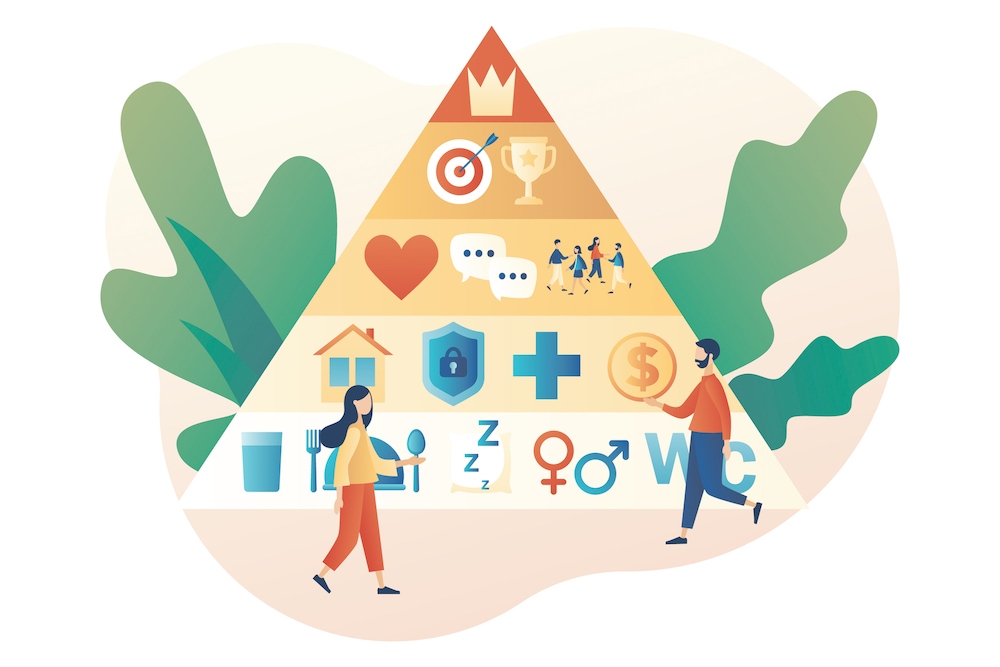Helping Clients Maslow’s Style

‘It is easy for clients to lose their ability to dream for a better future when they are in survival mode. The pressures of living on the brink of financial disaster can cause clients to make decisions that take them farther away from accomplishing their goals. However, motivating a client to dream is vital to their success and will help them give them the forward momentum to change their situation and make better choices.
An effective tool to help clients dream is Maslow’s Hierarchy of Needs or Maslow’s Theory, as it is sometimes called. Maslow’s Theory is well known in psychology circles, but is not directly related to finance. Maslow’s Hierarchy of Needs, is a five step pyramid approach to identifying a path to financial success that must be satisfied in order. That order begins with the foundational needs and progresses upward to the top.
See infographic below.

Maslow’s hierarchy of needs pyramid depicting elements of needs such as food, shelter, love, achievements, and a crown for self actualization
Maslow’s Hierarchy of Needs are sorted in priority order from foundational to self-actualization.
Physiological Needs
The first of these needs are physiological such as food, water, shelter, and transportation. Though transportation is not an innate need, it is essential in most areas to secure the best work options. These work options are necessary to secure income that provide for the innate needs and move the client to the next level of the pyramid.
Safety Needs
The second tier of the pyramid addresses safety needs. This is more of a feeling than an object, but clients will likely know what they need to feel safe. Perhaps they need to move to a better school district or a neighborhood with a lower crime rate? Perhaps they need to save to buy an alarm for their home or secure a better paying employment so they can save for an emergency fund? Everyone’s idea of safety is different, but in order to move up the pyramid, safety needs should be satisfied before progressing to love and belonging needs. When clients have a clear path forward, they are less likely to move backward. The lower needs on the pyramid form a firm foundation to build a healthier financial future.
Love And Belonging Needs
Love and belonging needs would include anything that will make the client feel they are loved. There are very expensive ways to fulfill this need such as treating friends to a night on the town and inexpensive ways like hosting a potluck dinner or a game night. Controlling the spending on this need is challenging, but with some out of the box thinking and creativity, it can be done. If you are familiar with the five love languages (words of affirmation, quality time, physical touch, acts of service, and receiving gifts), then you know everyone has a love action that is more meaningful for them. It could be that clients are spending money on gifts instead of giving their words, touch, or time, which could be more meaningful for the loved one.
Prioritizing Needs In The Right Order
Many clients will be tempted to prioritize the top part of the pyramid over the first two steps. However, if the priorities are satisfied out of order, it could jeopardize the foundational needs. Imagine if love and belonging takes the form of spending $200 every month eating out. For some clients, this could jeopardize paying for utilities. Not paying the utility bills will eventually lead the client back to satisfying physiological needs due to shut off notices that are sure to follow. However, some clients need a break on their way up the pyramid, so it is worth it to them to spend some (or a lot) on a higher priority. This is the client’s choice; counselors cannot want the client to succeed more than the client is willing to participate.
Self-Esteem Needs
The fourth step on Maslow’s Hierarchy of Needs is self-esteem. Self-esteem needs are the needs that make us feel we are worthy. In this area it is not uncommon to find there is an emotional attachment to money. Exploring a deeper relationship with ourselves often invokes feelings of shame or guilt. Shame could revolve around perceived inadequacies such as “I don’t make enough money,” or “I don’t know how to control my spending.” It can also make us feel guilty, “I want my child to have more,” or “I spent too much.” Also, feelings of abandonment or loneliness can be a slippery slope to overspending as well. Once the client finds their “why I spend,” it becomes easier to help them overcome their obstacles.
Self-Actualization Needs
The fifth and final category is the peak of the pyramid—self-actualization. At the height of the pyramid, we can see all of our primary needs are fulfilled and we can start to work toward inner peace with money. Since the idea of financial success is unique to every person, the realization of this category will likely be different for every client. For some this may mean they are able to live a comfortable life without the fear of running out of money; for others this may incorporate more lavish financial goals. Determining a client’s vision of self-actualization is easiest by daring the client to dream. Asking “If money were no object, how would you change your life?” is a great place to start.
Helping Your Clients Achieve Their Best Selves
By using Maslow’s Hierarchy of Needs, we can help clients be more intentional with their money. The upper half of Maslow’s pyramid tends to be more expensive than the lower, and debt can flip the hierarchy upside down. When clients recognize which need their spending is meeting, it makes it easier for them to see how their spending may be working against their goals. Therefore, when clients identify and prioritize their needs, it helps them achieve their best selves.